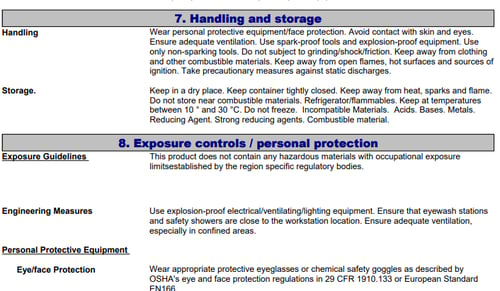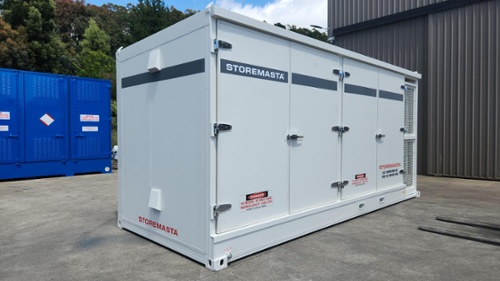While Australia is fortunate to have a warm and sunny climate, you need to be careful about what type of hazardous chemicals or dangerous goods you store in the outdoor environment. Temperature sensitive chemicals must be kept in controlled conditions, so that the safety, stability and usability of the stored substance is not compromised. In this post, we’ll be looking at the kind of chemicals that may require temperature controlled storage, as well as the solutions that can offer protection against extreme heat and cold.
What are Temperature Sensitive Chemicals?
Temperature sensitive chemicals are those substances and gases which require a specific temperature for handling and storage. These temperature guides are in place to control the risks associated with the chemical.
There are many types of chemicals that require specific environmental conditions to ensure safety and stability. Let’s have a look at some of the dangerous goods classes to further understand these types of chemicals.

Temperature sensitive chemicals, such as some Class 3 epoxies, must be kept in cool, dry conditions to prevent chemical hazards.
What Kind of Chemicals Need to be Stored in Climate Controlled Storage?
Some dangerous goods classes and non-hazardous chemicals that may require climate controlled storage include:
- Class 3 Flammable and Combustible Liquids
- Class 5.1 Oxidising agents
- Class 5.2 Organic Peroxides
- Class 6 Toxic Substances
- Class 8 Corrosive Substances
IMPORTANT: While these dangerous goods classes may require specific temperatures for storage, you must treat each product individually and refer to the Safety Data Sheet for information on temperature requirements. Even two products from different manufacturers may have different chemical storage and handling requirements, as per the individual Safety Data Sheet.
Examples of Temperature Sensitive Chemicals
Some examples of temperature sensitive chemicals that you may commonly find in the workplace include:
- Acetic acid
- Propionic acid
- Various epoxies
- Phenol
- Peroxyacetate
Are There Hazards Associated with Storing Chemicals at the Wrong Temperature?
There are a vast range of hazardous chemicals that need to be stored within a specific temperature range in order to maintain safety and effectiveness.
If the temperature of the storage facilities reaches outside the required chemical storage temperature range, it can create serious problems for your organization. The hazards could also be so serious that they affect nearby businesses, residents and the natural environment.
If substances aren’t handled or stored in the appropriate way, it can lead to:
- Health risks – such as the release of harmful gases
- Physical hazards – instances such as fire or chemical reactions
- Environmental impacts – harm to the environment and ecosystems if the chemical is released in either solid, liquid or vapour form
If not kept under the right conditions, your stored substances may become unstable or volatile, causing harm to people and property.
Chemicals may reach their autoignition temperature and spontaneously ignite. Some organic peroxide substances may exceed the self-accelerating decomposition temperature, causing them to undergo a decomposition reaction.
These temperature sensitive substances may also degrade or become completely unusable if they’re kept in warm conditions. This may not produce a physical or chemical hazard, but it results in a financial loss and inconvenience for the organisation that is carrying them.
How Do You Determine a Suitable Temperature for your Chemicals?
Chemical safety starts by correctly identifying your onsite substances, as well as knowing and implementing the guidelines for their handling and storage. One of the factors that you must consider when you’re reviewing your Safety Data Sheets is the conditions for safe chemical storage.
This will include specific parameters for temperatures, including a recommended minimum and maximum storage temperature.
What Parts of the Safety Data Sheet List Temperatures?
When referring to your Safety Data Sheet, make sure you thoroughly check the following sections to learn more about how your substances should be kept:
- Section 2: Hazard identification
- Section 7: Handling and storage
- Section 9: Physical and chemical properties
- Section 10: Stability and reactivity
REMEMBER: Make sure you consult the Safety Data Sheet for a chemical and its container label for specific storage requirements including any specific temperature conditions.

Your Safety Data Sheet, such as this SDS for peroxyacetate, will explain the temperatures for storage in various sections, including Section 7 Handling and storage.
Is a Risk Assessment Required for Heat Sensitive Chemicals?
In addition to referring to your Safety Data Sheet to determine your climate controlled storage needs, it’s important to remember to conduct an onsite risk assessment.
Your chemical risk assessment needs to begin with the identification of the substance and it’s hazards. These could include a vast range of hazards including the ability to ignite, corrode or react with other substances.
A thorough risk assessment is required to provide the correct controls to reduce the likelihood of a health, physical or environmental hazard.
Once your risk assessment has been conducted and all onsite chemicals and dangerous goods have been assessed, you can then move forward with your climate controlled storage needs.
But what kind of options are there available if you need temperature controlled storage for your workplace?
REMEMBER: Make sure special consideration is given to any substances that are volatile, such as flammable liquids, oxidizing agents and organic peroxides.
What is Temperature Controlled Storage?
Temperate controlled storage or climate controlled storage is a chemical storage facility that offers a controlled environment for the stored hazardous substances.
The temperature inside the unit must be suitable for the stored substances, as well as be able to be regulated regardless of the external conditions. Unlike standard chemical storage options, such as chemical cabinets or outdoor chemical stores, temperature controlled facilities allow organisations to operate safely in conditions that may not otherwise be suitable for the chemical.
Whether the storage facility features air conditioning, ventilation or a hazardous area rated HVAC systems, the store must provide a regulated environment for the chemicals to be stored in.
In addition to these features, it’s also important to ensure the safety and security of your chemical stock. Make sure your temperature control chemical storage facility is secure by investing in equipment with failsafe locking mechanisms for the doors, as well as the HVAC unit. This will prevent your dangerous goods from being stolen or tampered with.

Look for chemical storage facilities that offer temperature controls, as well as failsafe security to prevent unauthorised entry.
Operations including mines, manufacturing plants, laboratories, schools and universities are just some of the industries that utilise climate controlled chemical storage. Options may include temperature and/or humidity controlled cabinets, portable chemical storage reefers, temperature controlled chemical stores, refrigerated chemical storage and chemical freezers.
Need Some Help With Temperature Controlled Storage for your Jobsite?
If you’d like some further information about chemical storage for heat sensitive substances, get in touch with our DG Storage Specialists. Alternatively, you can learn more about chemical hazards and how to avoid them, by accessing our latest eBook The Ultimate DG Storage Handbook, where we go into further detail about chemical hazards, dangerous goods classes, risk assessments and the appropriate storage solutions.
Talarah has been working for Storemasta for many years, specialising in Marketing, Customer Service and Risk Management Solutions.

